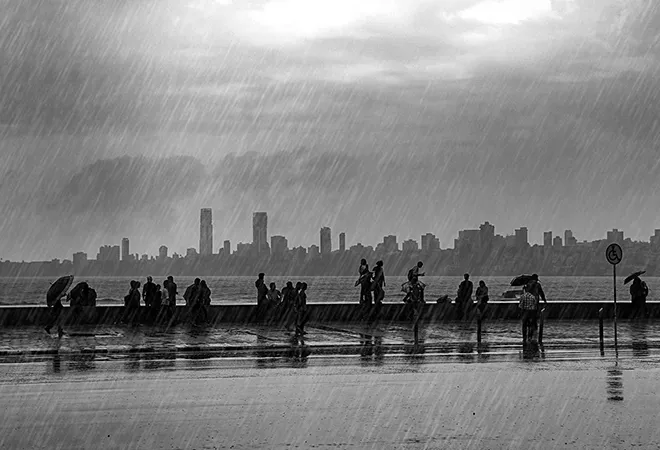
City governments in India are responsible for supplying water to citizens, however, despite their efforts, the entities never seem to have sufficient quantities of water to supply. Thus, some households receive only a few hours of supply every day, while many others in informal areas (such as slums) do not get water at all.
Not having enough (or no) water for consumption creates numerous problems in the lives of citizens. Some manage with lesser quantities received through pipelines, while others (i.e. poor communities), who do not have piped water connections within households, have to go out of their houses and spend time and extra money for obtaining water. Thus, on the one hand, the poor are struggling to earn a living, and on the other, they have to deal with the issue of collecting water every day.
With changing times, the significance of water is growing. Current times, since the outbreak of the COVID-19 pandemic, can be said to be very challenging for societies who require water in greater quantities. City governments need water for frequently sanitising public places and infrastructure; citizens for maintaining higher standards of hygiene. Not having access to sufficient water during this period means serious health and economic consequences for the nation. This is just one of the reasons for the government to actively work towards arranging a larger and sufficient stock of water for human consumption.
City governments need water for frequently sanitising public places and infrastructure; citizens for maintaining higher standards of hygiene. Not having access to sufficient water during this period means serious health and economic consequences for the nation.
It is surprising to note that water deficiencies exist even in those parts of India where surface water (i.e. rivers and lakes) and rainwater are available in abundance. The annual occurrences of southwest and northeast monsoon (moisture-laden winds which bring heavy rainfall) from July to September over almost the entire country play a major role in replenishing surface water bodies as well as groundwater.
Further, there are brief spells of rain occasionally due to weather disturbances during other times of the year. However, most cities including Chennai, Bengaluru, Pune, Mumbai, Delhi, Kolkata experience a water crisis year after year, particularly during the summer months when the demand is high. The prevailing conditions call for developing methods which can help city governments in addressing the growing water crisis.
A well-known method for collecting and storing water for use in future, as well as for recharging groundwater is “rainwater harvesting” (RWH). This involves collection of rainwater from roofs of buildings and in pits on the earth’s surface from where water is either transferred for treatment and reuse, or remains in the pits that percolates through the soil and recharges groundwater. This practice has been used effectively in many regions of ancient India including Magadh (now southern Bihar), the Deccan region, Indus valley, Dholavira (Kutch district of Gujarat), Sringaverapura (near Prayagraj), and Bundelkhand.
Most cities including Chennai, Bengaluru, Pune, Mumbai, Delhi, Kolkata experience a water crisis year after year, particularly during the summer months when the demand is high.
With changes in architecture, occupations, and introduction of various water supply technologies, the importance and use of RWH systems have reduced over time. It is perhaps thought that new systems are adequate to ensure water sufficiency. This has led to abandoning of numerous traditional water harvesting techniques and neglect of many interconnected water channels, canals, reservoirs, and tanks developed in the past.
Given the present day demand and supply challenges in cities, collecting water from multiple sources (surface water bodies, rainfall, and groundwater) in a balanced manner is a sensible approach. Presently, the government agencies mainly focus on surface and groundwater sources. While laws have been passed by many state and city governments in India for mandatory installation of RWH systems in buildings, this is marginally practised. Hence, a lot of rainwater received just flows away to wherever it finds its way. Efforts must be made to scale up this activity.
In Chennai, where the practice began in 2003, most government buildings introduced the system, but the RWH infrastructure created is old and needs upgradation. Moreover, not enough rainwater is being collected in the city. This is a major reason for the water shortage experienced in the city during summer months. Hyderabad presents a case where builders showcase harvesting pits to obtain occupancy certificates of high-rise apartments and gated communities, but thereafter, the method is not practiced which leads to deterioration of pits and other infrastructure.
Given the present day demand and supply challenges in cities, collecting water from multiple sources (surface water bodies, rainfall, and groundwater) in a balanced manner is a sensible approach.
In Bengaluru, thousands of building owners (65,464 homes) defy the 2009 rule of installing RWH facilities, and have no problem in paying fines. Even in Mumbai, which receives abundant rainfall every year (about 2,457 mm), adequate efforts are not being made to save rainwater. Moreover, the civic agency, which made RWH mandatory in 2002 for all new constructions above 1,000 sq.m., has insufficient record of currently operational RWH systems in the city. Gurugram, which experiences water logging during every monsoon, plans to develop RWH units at various locations in the city. According to reports, work on desilting and cleaning of drains is underway and about 30 water logging-prone sites have been identified.
The Delhi government in 2012 made it compulsory for house owners/housing societies, and other establishments (including public and private) having plot/property of size 500 sq.m. or more to install RWH systems within premises. More recently in 2019, this rule was amended to include properties with an area of 100 sq. m. and above. Available data show that 15,706 RWH units are registered with Delhi Jal Board (DJB). Most of these are installed in government buildings and schools, and a very less number (1,254 establishments — private houses/housing societies, etc.) have followed this directive. The slow progress is due to lack of vacant space for building rainwater storage tanks/pits, investment of time and money (over one lakh rupees for small units and maintenance of pits). Private companies, on the other hand, who are interested in installing RWH systems, are concerned about the lengthy process of taking permission from government agencies. It is unfortunate that while Delhi receives over 600 mm of average rainfall in a year, very little is being harvested.
The city level analysis presented above reveals that while many Indian state and city governments have passed the law for mandatory harvesting of rainwater from roof tops of buildings, achievement on the ground is very less. The situation today is that RWH units are installed in some government buildings, and few houses/housing societies. Further, as mentioned above, enough efforts are not being made by the government to maintain a list of operational and dysfunctional units within a city.
Given the challenges involved, significant progress in harvesting larger quantities of rainwater from building rooftops would take a very long time. While this matter needs to be pursued by making the society more aware about water conservation benefits, city governments can establish RWH structures and pits at vacant places along roads, flyovers, near water-logged areas, and other open spaces, where a lot of rainwater collects. Such infrastructure can also be established near slums and unauthorised colonies which are uncovered by piped networks and are constantly faced with water shortages.
If at the household level, people are not coming forward, the government can set a good example by creating RWH structures and pits at potential public places in the city. This would involve engaging with private technological companies who have the expertise, as well as with the community organisations for managing the RWH facilities.
The views expressed above belong to the author(s). ORF research and analyses now available on Telegram! Click here to access our curated content — blogs, longforms and interviews.




 PREV
PREV


